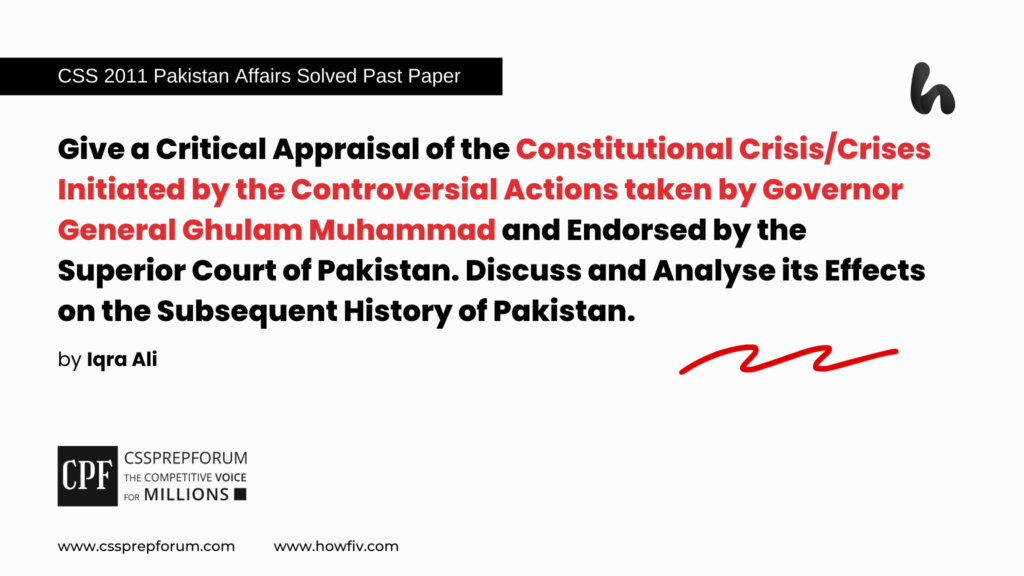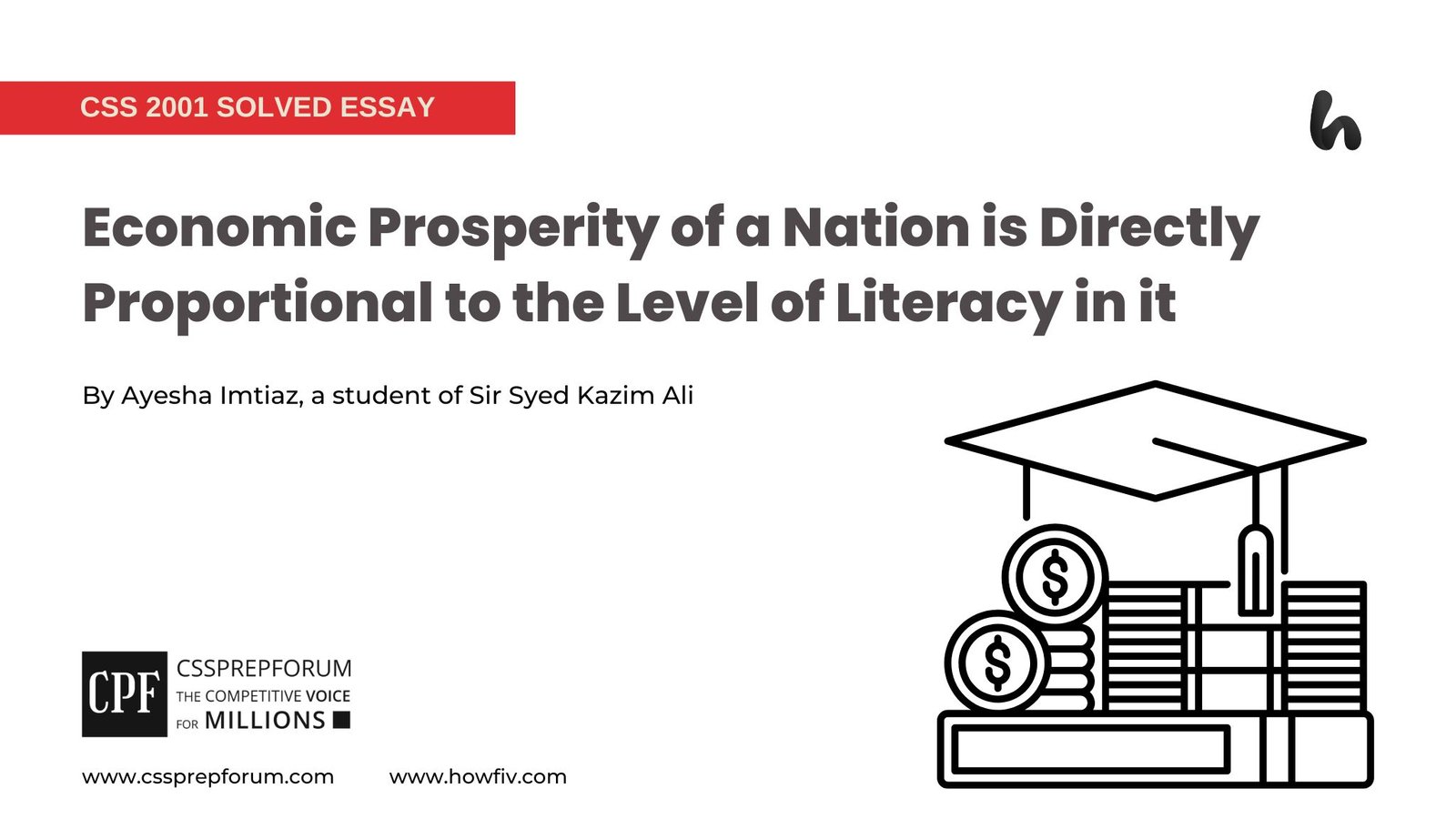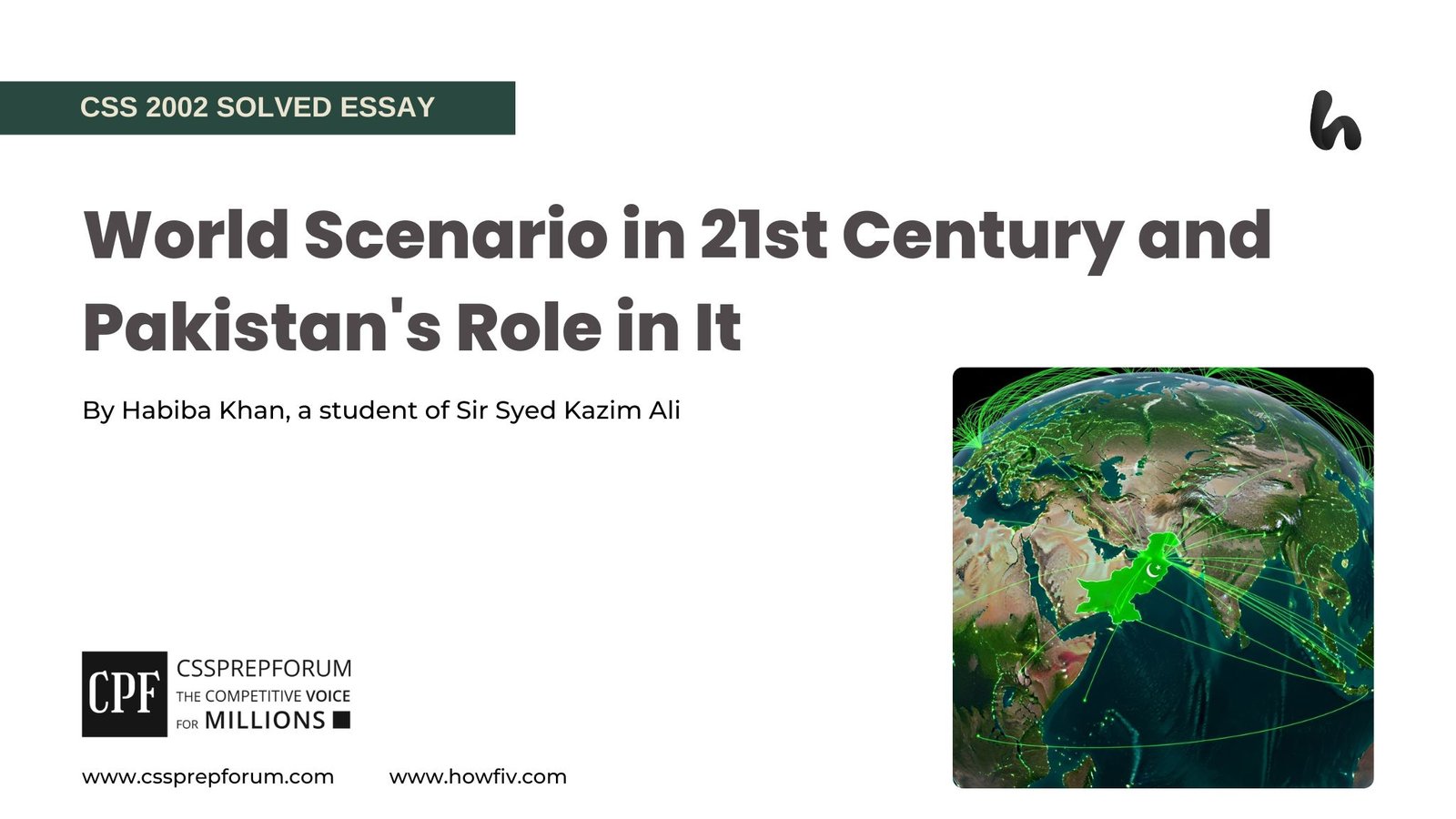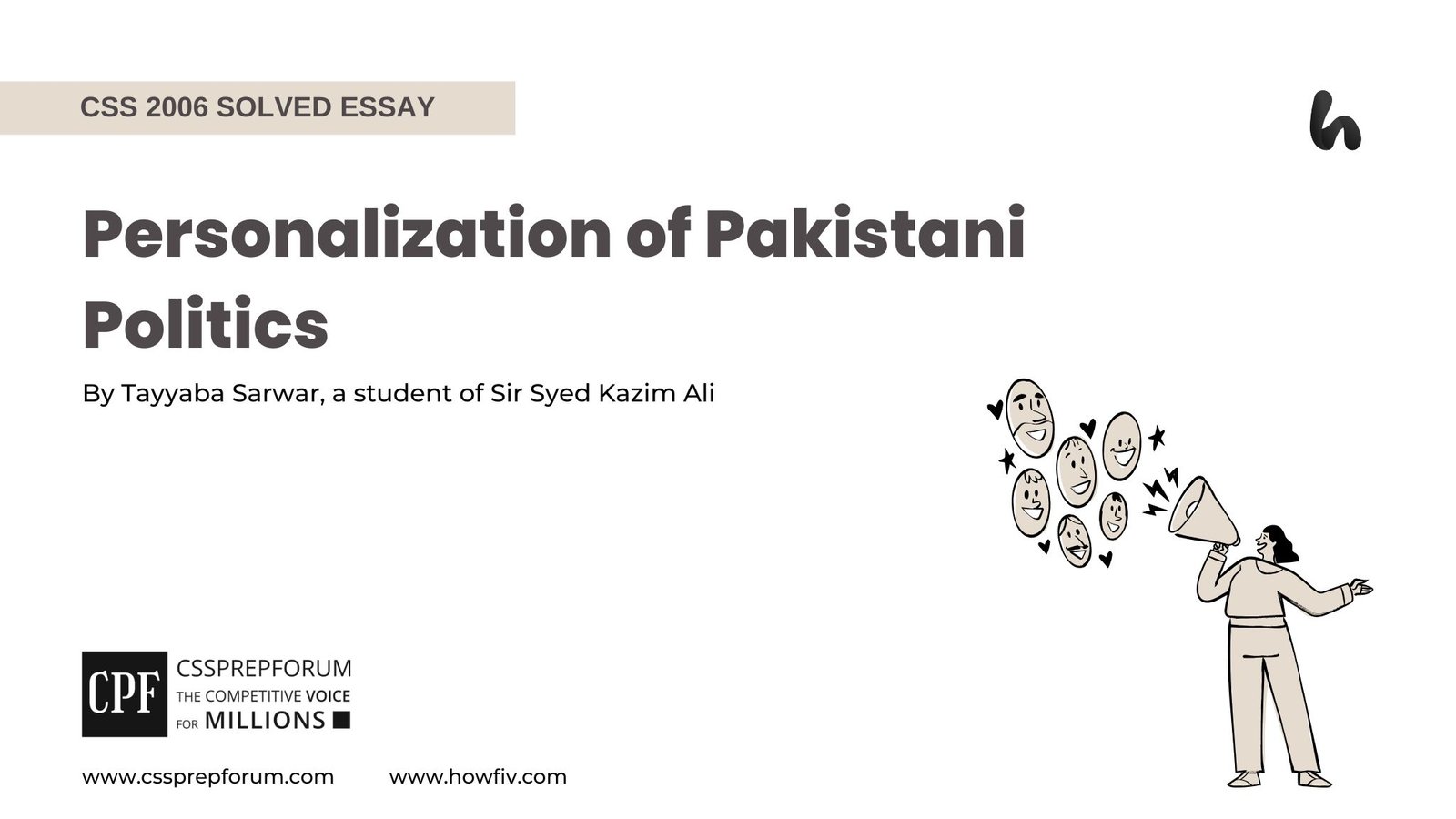CSS 2011 Solved Pakistan Affairs Past Papers | Constitutional Crisis of Pakistan throughout its History
The following question of CSS Pakistan Affairs 2011 is solved by Miss Iqra Ali, the best Pakistan Affairs Coach, on the guided pattern of Sir Syed Kazim Ali, which he taught to his students, scoring the highest marks in compulsory subjects for years. This solved past paper question is uploaded to help aspirants understand how to crack a topic or question, how to write relevantly, what coherence is, and how to include and connect ideas, opinions, and suggestions to score the maximum.

Question Breakdown
In this question, the examiner has asked you to give a critical appraisal of the constitutional crises initiated by the controversial actions taken by Governor General Ghulam Muhammad and endorsed by the Superior Court of Pakistan. Further, he asked to discuss and analyze its effects on the subsequent history of Pakistan. Start with an introduction, which will include all the leading points of your answer. Then, split your answer into two parts. Last, end your answer with a conclusion.
Outline
1-Introduction
2-Path to Partition: Constitutional Foundations of Pakistan (1946–1947)
3-The Controversial Actions of Governor General Ghulam Muhammad and Response of Moulvi Tamizuddin Khan
- ✓ Executive Over-reach, Dismissing the Prime Minister Khuwaja Nazimuddin
- ✓ Constitutional Assembly Tackled the Growing Influence of Bureaucratic-Military Establishment
- ✓ Breakdown of Constitutional Machinery, the Governor-General Dissolved the Constitutional Assembly
4-On Which Basis the Superior Court Endorsed the Actions of the Governor General?
- ✓ Point Raised on Assent of the Governor-General, the Reversal of the Sindh’s Courts Judgement by the Federal Court
5-Critical Analysis of the Effects of the Decision on the Subsequent Political History of Pakistan
6-Conclusion

Answer to the Question
Introduction
The Constitution of a country provides it with a framework of governance, ensures its stability and sovereignty, guarantees fundamental rights to its citizens, and establishes the rule of law. However, a constitutional crisis can undermine the state’s sovereignty and cause irreparable harm to its socio-economic development. Unfortunately, in the case of Pakistan, the country has faced a constitutional crisis in its infancy that caused incalculable harm to the development of democratic institutions. The responsibility for the constitutional crisis is attributed to the actions of the governor-general Ghulam Muhammad, followed by the legitimization of his actions by the Federal Court of the country. He, the governor-general, dissolved the first Constitutional Assembly on 24th Oct 1954 when Moulvi Tamizuddin Khan, president of the Assembly, tried to restrict the arbitrary powers of the office of the governor-general exercised to dismiss his political rivals. As a result, the governor-general proclaimed an emergency and dissolved the Assembly. Moulvi Tamizddun Khan challenged his actions in the Sindh Court, and the judgment legitimized his standing. The federal government appealed to the Federal Court, challenging the Sindh Court judgment. The Court favoured the actions of the governor-general under the umbrella of the ‘doctrine of necessity’. To conclude, the actions of the governor-general Ghulam Mohammad to sustain his rule and strengthen the power led to a constitutional crisis in the country. It weakened the development of democratic institutions by strengthening the power and control of the military bureaucratic establishment.
Path to Partition: Constitutional Foundations of Pakistan (1946–1947)
In Undivided India, on 16th May 1946, Prime Minister Clement Atlee announced the recommendations of the Cabinet Mission Plan regarding the establishment of a Constitutional Assembly for the formulation of constitutions for the two new dominions. The All-India Muslim League boycotted the idea of a joint Constitutional Assembly and demanded a separate assembly for Pakistan. On June 3rd, 1946, his majesty-George VI announced specific provisions in relation to the establishment of a separate assembly. The assembly was created under the direction of Governor-General Mountbatten. Jinnah was elected as the first president of the Constitutional Assembly on 11th Aug 1947. Following Jinnah’s death on 11th September 1948, Maulvi Tamizuddin Khan was elected as the president of the assembly on 14th December 1948.
The Controversial Actions of Governor General Ghulam Muhammad and Response of Moulvi Tamizuddin Khan
- ✓ Executive Over-reach, Dismissing the Prime Minister Khuwaja Nazimuddin
On 17th April 1953, the third governor-general of Pakistan (1951-55), a politician and economist, Sir Malik Ghulam Muhammad, replaced Khuwaja Nazimuddin-the second prime minister, with Muhammad Ali Bogra by exercising the rights of the governor-general provided in Section 10 (2) of the Government of India Act 1935. According to Section 10 (2) of the Government of India Act of 1935, the Governor-General’s ministers shall be chosen and summoned by him, shall be sworn as members of the council, and shall hold office during his pleasure. The functions of the governor-general with respect to the choosing and summoning of the dismissal shall be exercised by him at his discretion. The dismissal can be referred to as executive over-reach undermining civilian rule. It was based on the power struggle between civil leadership and Bureaucratic-military establishment. However, the governor-general cited economic failure, law-and-order issues, and political instability as justifications for the dismissal.
- ✓ Constitutional Assembly Tackled the Growing Influence of Bureaucratic-Military Establishment
As a result, the Constitutional Assembly passed two bills: first, Section 223-A was added to the Government of India Act 1935. It invested the courts with the power of mandamus and quo-warranto, and second, a bill was passed on 21st September 1954 that repealed Section 10 (2). At that time, Moulvi Tamizuddin was the president of the Constitutional Assembly. The bills did not get the assent of the governor-general on account of their absence.
- ✓ Breakdown of Constitutional Machinery, the Governor-General Dissolved the Constitutional Assembly
So, upon returning to Pakistan, the governor-general dissolved the Assembly on 24th Oct 1954. Moulvi Tmizuddin Khan challenged the actions of the governor-general in the Sindh Court. As a result, the Sindh Chief Court issued quo-warranto to the ministers in the Bogra Cabinet. So, they were inhibited from exercising the office of minister. Also, the court issued a writ of mandamus that restored Moulvi Tamizuddin Khan to the office of president of the Constitutional Assembly. It also restrained respondents from interfering in his duties as president of the Assembly. Resultantly, the government appealed in the superior court against the ruling of the Sindh Chief Court.
On Which Basis the Superior Court Endorsed the Actions of the Governor General?
- ✓ Point Raised on Assent of the Governor-General, the Reversal of the Sindh’s Courts Judgement by the Federal Court
The Federal Court reversed the judgment of the Sindh Court on the grounds that the bills did not get the assent of the governor-general. It did not address the issue that the Assembly was rightly dissolved or not. It was held that under Section 223 A, which was not yet a law, the Sindh Court issued a writ in favor of Moulvi Tamizuddin. In addition, all the enactments of the Assembly required the assent of the governor-general. So, it was declared that the Sindh Court had no power to issue writs. Then, the court interpreted the Indian Independence Act of 1947 and held that the governor-general was a constituent part of the Assembly or Federal legislature. So, his assent is required. It was said that the Assembly, in its functions, was under limitations imposed upon it by the Government of India Act 1935. Last, by a majority of four to one, the court decided in favor of the government and rejected Moulvi Tamizuddin Khan’s petition.
Critical Analysis of the Effects of the Decision on the Subsequent Political History of Pakistan
In a critical analysis, the decision strengthened military and bureaucratic control on the decision-making cadre. In later political history, it is evident that military dictators legitimize their rule under the ‘doctrine of necessity’. Further, it weakened constitutionalism by legalizing the authoritarian rule that gave space to future endeavours by the military bureaucracy establishment. The dissolution of the Constitutional Assembly further delayed constitutional developments. As a result, the state’s constitution was formalized after ten years of its establishment. Hamid Khan writes in the book Constitutional and Political History of Pakistan that the judgment irreparably undermined the image and credibility of the judiciary of Pakistan in the public eye. Thus, the decision caused irreparable harm to the development of strong democratic institutions.
Conclusion
To conclude, the actions of Governor General Ghulam Muhammad to strengthen the position of the bureaucratic-military establishment in the decision-making cadre impacted the constitutional development of the country in its earlier phase. The decision of the Federal Court on the question of whether the dissolution of the first Constitutional Assembly was right was not even addressed. Notably, it legitimized the actions of the governor-general. Thus, it impacted the image of the judiciary in an unprecedented way. The decision strengthened military and bureaucratic control on the decision-making cadre. In later political history, it is evident that military dictators legitimize their rule under the ‘doctrine of necessity.
CSS Solved Past Papers’ Essays
Looking for the last ten years of CSS and PMS Solved Essays and want to know how Sir Kazim’s students write and score the highest marks in the essays’ papers? Then, click on the CSS Solved Essays to start reading them.
CSS Solved Essays
CSS Solved General Science & Ability Past Papers
Want to read the last ten years’ General Science & Ability Solved Past Papers to learn how to attempt them and to score high? Let’s click on the link below to read them all freely. All past papers have been solved by Pakistan’s top CSS GSA coach having the highest score of their students.
General Science & Ability Solved Past Papers












